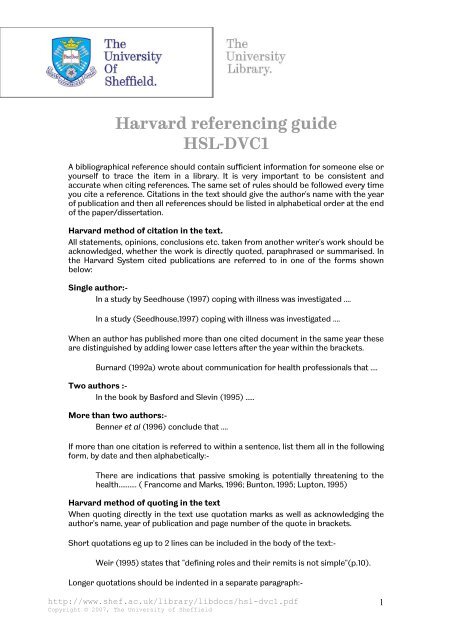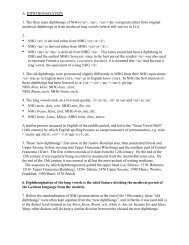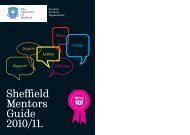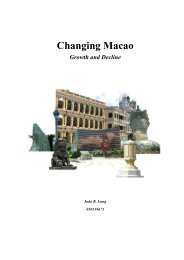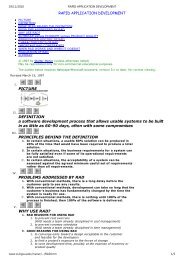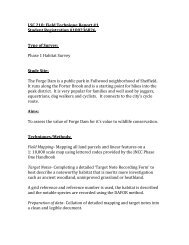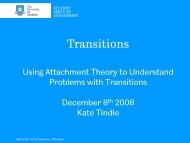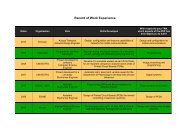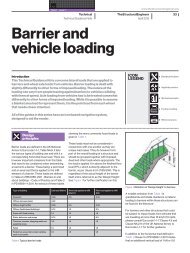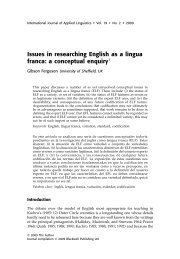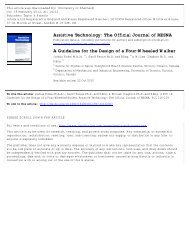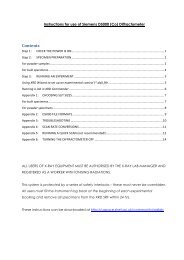Harvard referencing guide HSL-DVC1 - University of Sheffield
Harvard referencing guide HSL-DVC1 - University of Sheffield
Harvard referencing guide HSL-DVC1 - University of Sheffield
You also want an ePaper? Increase the reach of your titles
YUMPU automatically turns print PDFs into web optimized ePapers that Google loves.
<strong>Harvard</strong> <strong>referencing</strong> <strong>guide</strong><br />
<strong>HSL</strong>-<strong>DVC1</strong><br />
A bibliographical reference should contain sufficient information for someone else or<br />
yourself to trace the item in a library. It is very important to be consistent and<br />
accurate when citing references. The same set <strong>of</strong> rules should be followed every time<br />
you cite a reference. Citations in the text should give the author's name with the year<br />
<strong>of</strong> publication and then all references should be listed in alphabetical order at the end<br />
<strong>of</strong> the paper/dissertation.<br />
<strong>Harvard</strong> method <strong>of</strong> citation in the text.<br />
All statements, opinions, conclusions etc. taken from another writer's work should be<br />
acknowledged, whether the work is directly quoted, paraphrased or summarised. In<br />
the <strong>Harvard</strong> System cited publications are referred to in one <strong>of</strong> the forms shown<br />
below:<br />
Single author:-<br />
In a study by Seedhouse (1997) coping with illness was investigated ....<br />
In a study (Seedhouse,1997) coping with illness was investigated ....<br />
When an author has published more than one cited document in the same year these<br />
are distinguished by adding lower case letters after the year within the brackets.<br />
Burnard (1992a) wrote about communication for health pr<strong>of</strong>essionals that ....<br />
Two authors :-<br />
In the book by Basford and Slevin (1995) .....<br />
More than two authors:-<br />
Benner et al (1996) conclude that ....<br />
If more than one citation is referred to within a sentence, list them all in the following<br />
form, by date and then alphabetically:-<br />
There are indications that passive smoking is potentially threatening to the<br />
health.......... ( Francome and Marks, 1996; Bunton, 1995; Lupton, 1995)<br />
<strong>Harvard</strong> method <strong>of</strong> quoting in the text<br />
When quoting directly in the text use quotation marks as well as acknowledging the<br />
author's name, year <strong>of</strong> publication and page number <strong>of</strong> the quote in brackets.<br />
Short quotations eg up to 2 lines can be included in the body <strong>of</strong> the text:-<br />
Weir (1995) states that "defining roles and their remits is not simple"(p.10).<br />
Longer quotations should be indented in a separate paragraph:-<br />
http://www.shef.ac.uk/library/libdocs/hsl-dvc1.pdf<br />
Copyright © 2007, The <strong>University</strong> <strong>of</strong> <strong>Sheffield</strong><br />
1
Thomas and Ingham (1995) in discussing staff development state that:<br />
"Development is infectious, and staff who previously have recoiled<br />
from undertaking a degree or conversion course have been<br />
encouraged by the success <strong>of</strong> others"(p.33).<br />
If part <strong>of</strong> the quotation is omitted then this can be indicated using three dots:-<br />
Weir and Kendrick (1995) state that "networking is no longer solely within the<br />
male domain . . ."(p.88).<br />
Secondary <strong>referencing</strong><br />
Secondary <strong>referencing</strong> is when one author is referring to the work <strong>of</strong> another and the<br />
primary source is not available. You should cite the primary source and the source<br />
you have read eg (Fiedler and Chemers, 1974, cited in Douglass, 1996). Secondary<br />
<strong>referencing</strong> should be avoided if at all possible.<br />
<strong>Harvard</strong> method <strong>of</strong> listing references at the end <strong>of</strong> the text<br />
References should be listed in alphabetical order by author's name and then by date<br />
(earliest first), and then if more than one item has been published during a specific<br />
year by letter (1995a, 1995b etc). Whenever possible details should be taken from the<br />
title page <strong>of</strong> a publication and not from the front cover, which may be different. Each<br />
reference should include the elements and punctuation given in the examples below.<br />
Authors' forenames can be included if given on the title page but they are not<br />
required to be. The title <strong>of</strong> the publication should either be in italics or underlined.<br />
The examples given are in italics:<br />
A book by a single author:<br />
Seedhouse, D. (1997) Health promotion: philosophy, prejudice and practice.<br />
Chichester, John Wiley.<br />
A book by two authors:<br />
Burns, Nancy and Grove, Susan K. (1997) The practice <strong>of</strong> nursing research:<br />
conduct, critique & utilization. 3rd edition. London, Saunders.<br />
A book by more than two authors:<br />
Mares, Penny et al. (1995) Health care in multiracial Britain. Cambridge,<br />
Health Education Council.<br />
A book by a corporate author (eg a government department or other<br />
organisation):<br />
Health Visitors' Association (1992) Principles into practice : an HVA position<br />
statement on health visiting and school nursing. London, Health Visitors'<br />
Association.<br />
An edited book:<br />
Basford, Lynn and Slevin, Oliver (eds) (1995) Theory and practice <strong>of</strong> nursing:<br />
an integrated approach to patient care. Edinburgh, Campion.<br />
A chapter in a book:<br />
Weir, Pauline (1995) Clinical practice development role: a personal reflection.<br />
In: K. Kendrick et al. (eds) Innovations in nursing practice. London, Edward<br />
Arnold. p. 5- 22.<br />
An article in a journal:<br />
Allen, A. (1993) Changing theory in nursing practice. Senior Nurse, 13(1), 43-5.<br />
An article in a newspaper:<br />
White, M. (1998) £68m to cut NHS waiting lists. Guardian, Monday May 18<br />
1998, p.8.<br />
http://www.shef.ac.uk/library/libdocs/hsl-dvc1.pdf<br />
Copyright © 2007, The <strong>University</strong> <strong>of</strong> <strong>Sheffield</strong><br />
2
If no author name is given then anon should be used instead.<br />
Anon (1998) Schemes to boost dental care. Guardian, Monday May 18 1998,<br />
p.8.<br />
Government publications<br />
In broad terms White Papers contain statements <strong>of</strong> Government policy while Green<br />
Papers put forward proposals for consideration and public discussion. They are cited<br />
in the same way.<br />
A White paper:<br />
Department <strong>of</strong> Health (1996) Choice and opportunity: primary care: the future.<br />
Cm.3390. London, Stationery Office.<br />
A Green paper:<br />
Department <strong>of</strong> Health (1998) Our Healthier Nation: a contract for health. Cm<br />
3854. London, Stationery Office.<br />
An Act <strong>of</strong> Parliament:<br />
Great Britain (1990) National Health Service and Community Care Act 1990.<br />
Chapter 19. London, HMSO.<br />
Conference proceedings:<br />
Published conference proceedings with author or editor(s):<br />
Banks, S. et al (1998) Networked Lifelong Learning: innovative approaches to<br />
education and training through the Internet: Proceedings <strong>of</strong> the 1998<br />
International Conference held at the <strong>University</strong> <strong>of</strong> <strong>Sheffield</strong>.<br />
<strong>Sheffield</strong>,<strong>University</strong> <strong>of</strong> <strong>Sheffield</strong>.<br />
Paper from published conference proceedings with author or editor(s):<br />
Proctor, P. (1998) The tutorial: combining asynchronous and synchronous<br />
learning. In: Banks, S. et al. Networked Lifelong Learning: innovative<br />
approaches to education and training through the Internet: Proceedings <strong>of</strong><br />
the 1998 International Conference held at the <strong>University</strong> <strong>of</strong> <strong>Sheffield</strong>. <strong>Sheffield</strong>,<br />
<strong>University</strong> <strong>of</strong> <strong>Sheffield</strong>. p.3.1 - 3.7.<br />
If no author or editor is given on the title page the name <strong>of</strong> the conference is cited<br />
first either in italics or underlined.<br />
A thesis or dissertation:<br />
Stones, Marian (1995) Women, nurses, education: an oral history taking<br />
technique. Unpublished M.Ed. dissertation, <strong>University</strong> <strong>of</strong> <strong>Sheffield</strong>.<br />
A secondary reference:<br />
Fiedler, F. and Chemers, M. (1974) Leadership and effective management.<br />
Glenview, Illinois, Scott Foresman & Co. Cited in: Douglass, Laura Mae (1996)<br />
The effective nurse: leader and manager. 5th edition. St. Louis, Missouri,<br />
Mosby.<br />
Acknowledgements:<br />
The following documents have been used in the compilation <strong>of</strong> this <strong>guide</strong> and further<br />
information can be obtained from them.<br />
Bournemouth <strong>University</strong>. Academic Services Group. Library and Information Services.<br />
(1996) <strong>Harvard</strong> System. [online] Bournemouth, Bournemouth <strong>University</strong>. [Accessed<br />
9th June 1996].<br />
http://www.shef.ac.uk/library/libdocs/hsl-dvc1.pdf<br />
Copyright © 2007, The <strong>University</strong> <strong>of</strong> <strong>Sheffield</strong><br />
3
British Standards Institution (1989) BS Recommendations for references to published<br />
materials. BS.1629:1989. London, BSI.<br />
<strong>University</strong> <strong>of</strong> <strong>Sheffield</strong>. Library. (1997) Writing a bibliography. ML-RS11. [online]<br />
<strong>Sheffield</strong>, <strong>University</strong> <strong>of</strong> <strong>Sheffield</strong>. Available from:<br />
http://www.shef.ac.uk/library/libdocs/ml-rs11.pdf [Accessed 9th June 1998].<br />
Citing electronic sources <strong>of</strong> information<br />
There is a separate <strong>guide</strong> giving details <strong>of</strong> how to cite electronic sources <strong>of</strong><br />
information: “Citing electronic sources <strong>of</strong> information” (Guide: <strong>HSL</strong>-DVC2) which can<br />
be obtained from any <strong>of</strong> the libraries serving the School <strong>of</strong> Nursing and Midwifery.<br />
For further information contact your Academic Liaison Librarian.<br />
http://www.shef.ac.uk/library/libdocs/hsl-dvc1.pdf<br />
Copyright © 2007, The <strong>University</strong> <strong>of</strong> <strong>Sheffield</strong><br />
4


